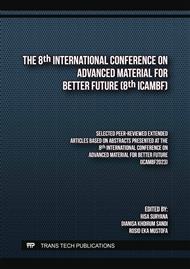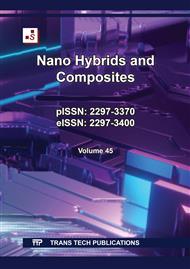[1]
N. Hayeemasae, Z. Sensem, I. Surya, K. Sahakaro, H. Ismail, Synergistic Effect of Maleated Natural Rubber and Modified Palm Stearin as Dual Compatibilizers in Composites based on Natural Rubber and Halloysite Nanotubes, Polymers, 12 (4) (2020) 766.
DOI: 10.3390/polym12040766
Google Scholar
[2]
V. Arrighi, I. McEwen, H. Qian, M. S Prieto, The glass transition and interfacial layer in styrene-butadiene rubber containing silica nanofiller, Polymers, 44 (2003) 6259–6266.
DOI: 10.1016/s0032-3861(03)00667-0
Google Scholar
[3]
I. Surya, N Hayeemasae, Oleamide as palm-oil based substance for silica-loaded styrene butadiene rubber compound: The cure and crosslinks behaviors, IOP Conference Series: Earth and Environmental Science, 1241 (2023) 012096.
DOI: 10.1088/1755-1315/1241/1/012096
Google Scholar
[4]
M. Akiba & A. Hashim, Vulcanization and crosslinking in elastomers, Progress in polymer science, 22 (3) (1997) 475-521.
DOI: 10.1016/s0079-6700(96)00015-9
Google Scholar
[5]
I. Surya, M. Marpongahtun, The NR/silica/silane composites: Study on the crosslinks behaviour and tensile strength, AIP Conference Proceedings, 2626 (1) (2023) 040016.
DOI: 10.1063/5.0136043
Google Scholar
[6]
McKinney K, Michele and F.C. Benjamin, Structure and function of fatty acid amide hydrolase, Annual Review of Biochemistry, 74 (1) (2005) 411-432.
DOI: 10.1146/annurev.biochem.74.082803.133450
Google Scholar
[7]
I. Surya, J. Anto, The properties of hardness and swelling of styrene butadiene rubber/silica/ oleamide composites, IOP Conference Series: Earth and Environmental Science, 1188 (1) (2023) 012015.
DOI: 10.1088/1755-1315/1188/1/012015
Google Scholar
[8]
I. Surya, M. Ginting, Studying on the carbon black-reinforced styrene butadiene rubber: Effect of stearamide adding on the rheological behavior, AIP Conference Proceedings, 2626 (1) (2023) 130003.
DOI: 10.1063/5.0136050
Google Scholar
[9]
I. Surya, M. Ginting, The silica-filled polychloroprene rubber in the addition of alkanolamide: tensile and vulcanization properties, IOP Conference Series: Materials Science and Engineering 801 (1) (2020) 012089.
DOI: 10.1088/1757-899x/801/1/012089
Google Scholar
[10]
[A. A. Abdelsalam, A. Sherif, H. Salwa, S. H. El-Sabbagh, A. Abdelmoneim, A. H. Mohsen, Journal of Thermoplastic Composite Materials, 1 (18) (2019) 1-14.
Google Scholar
[11]
K.N. Hafni, I. Surya, NR/precipitated silica/dodecanol composites: Torque, hardness and morphology behaviors, IOP Conference Series: Materials Science and Engineering, 1122 (1) (2021) 012115.
DOI: 10.1088/1757-899x/1122/1/012115
Google Scholar
[12]
H. Yang, L. Yang, H. Guo, W. Hu, & A. Du, The effect of silica modified by deep eutectic solvents on the properties of nature rubber/silica composites, Journal of Elastomers & Plastics, (2021) 009524432110200.
DOI: 10.1177/00952443211020051
Google Scholar
[13]
H. Ismail and H. Chia, European Polymer Journal, 34 (12) (1998) 1857-1863.
Google Scholar
[14]
K. Polmanteer, C. Lentz, Rubber Chemistry and Technology, 48 (5) (1975) 795-809.
Google Scholar
[15]
I. Surya, E. Edwin, J. Anto, AIP Conference Proceedings, 2221 (2020) 012094.
Google Scholar
[16]
H. Ismail and M. Mathialagan, Comparative study on the effect of partial replacement of silica or calcium carbonate by bentonite on the properties of EPDM composites, Polymer Testing, 31 (2) (2012) 199-208.
DOI: 10.1016/j.polymertesting.2011.09.002
Google Scholar
[17]
H. Nabil, H. Ismail, and A. Azura, Compounding, mechanical and morphological properties of carbon-black-filled natural rubber/recycled ethylene-propylene-diene-monomer (NR/R-EPDM) blends, Polymer Testing, 32 (2) (2013) 385-393.
DOI: 10.1016/j.polymertesting.2012.11.003
Google Scholar



